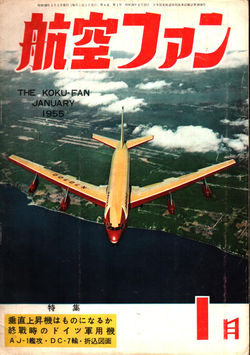KOKU
FAN 1/55 B707 DASH 80_AJ-1 SAVAGE USN_DC-7_A2D-1_T-28B_Me163_Me262_He162_Ju287V
TEXT IS PRIMARILY IN JAPANESE
------------------------------------------------------
Additional Information from
Internet Encyclopedia
During and after World War II,
Boeing was known for its military aircraft. The company had produced innovative
and important bombers, from the B-17 Flying Fortress and B-29 Superfortress, to
the jet-powered B-47 Stratojet and B-52 Stratofortress. The company's civil
aviation department lagged far behind Douglas and other competitors, the only
noteworthy airliners being the Boeing 314 Clipper and 307 Stratoliner. During
1949 and 1950, Boeing embarked on studies for a new jet transport, realizing
that any design must be aimed at both military and civilian markets. Aerial
refueling was becoming a standard technique for military aircraft, with over
800 KC-97 Stratofreighters on order. With the advent of the Jet Age, a new
tanker was required to meet the USAF's fleet of jet-powered bombers; this was
where Boeing's new design would win military orders.
Boeing studied numerous wing and
engine layouts for its new transport/tanker, some of which were based on the
B-47 and C-97, before settling on the 367-80 quadjet prototype aircraft. The
"Dash 80" took less than two years from project launch in 1952 to
rollout on May 14, 1954, then first flew on July 15, 1954. It was powered by
the Pratt & Whitney JT3C turbojet engine, the civilian version of the J57
used on many military aircraft, including the F-100 Super Sabre fighter and the
B-52 bomber. The prototype was a proof-of-concept aircraft for both military
and civilian use. The United States Air Force was the first customer, using it
as the basis for the KC-135 Stratotanker aerial refueling airplane.
Whether the passenger 707 would
be profitable was far from certain. At the time, nearly all of Boeing's revenue
came from military contracts. Its last passenger aircraft, the Boeing 377
Stratocruiser, had netted the company a $15 million loss before it was
purchased by the Air Force as the KC-97 Stratofreighter. In a demonstration
flight over Lake Washington outside Seattle, on August 7, 1955, test pilot Tex
Johnston performed a barrel roll in the 367-80 prototype. Although he justified
his unauthorized action to Bill Allen, the president of Boeing, as selling the
airplane with a 1 'g' manoeuvre he was told not to do it again.
The 132 in (3,352.80 mm) wide
fuselage of the Dash 80 was large enough for four-abreast (two-plus-two)
seating like the Stratocruiser. Answering customers' demands and under Douglas
competition, Boeing soon realized this would not provide a viable payload, so
it widened the fuselage to 144 in (3,660 mm) to allow five-abreast seating and
use of the KC-135's tooling. Douglas Aircraft had launched its DC-8 with a
fuselage width of 147 in (3,730 mm). The airlines liked the extra space and
six-abreast seating, so Boeing increased the 707's width again to compete, this
time to 148 in (3,760 mm).





